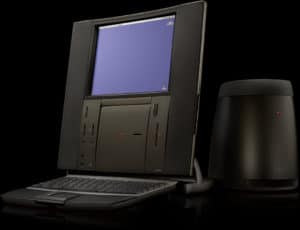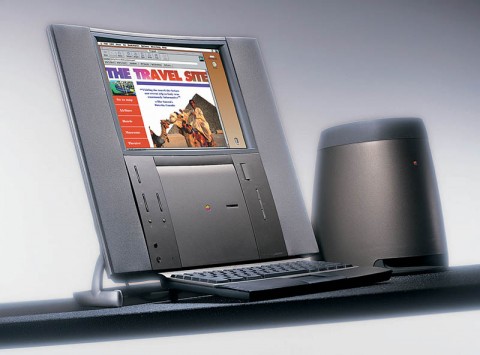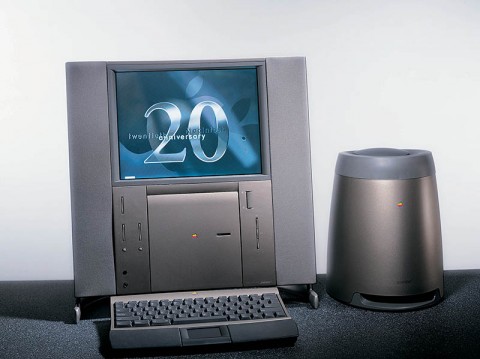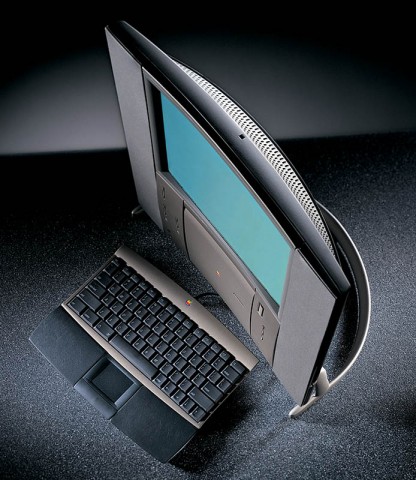
Apple is now (2017) the most valuable company in the world. But 20 years ago it looked like the company was about to completely implode. Nevertheless Apple was celebrating it’s anniversary. It had been twenty years since Apple had officially incorporated, and it marked the occasion with the Twentieth Anniversary Macintosh, or TAM. The machine was a technological showcase of the day, boasting a number of features beyond simple computing, and with a price tag aimed at the “executive” market.
Released on March 20, 1997, the TAM was essentially the computing version of a concept car, an innovation showcase. It compared to a car in another way: it was expensive, costing $7,499 upon its release. After its launch event, The New York Times called the ambitious effort a “Ferrari-on-a-desktop.”
The TAM was an all-in-one PC, kind of a spiritual ancestor of the iMac, back when the whole idea of a monitor that contains the computer was totally crazy. It was designed by a young Jony Ive, who would go on to become Apple’s resident creative genius.
April 1, 1996 marked 20 years since the day that Steve Jobs, Steve Wozniak, and Ronald Wayne came together to form Apple Computer. As this milestone arrived and came to the attention of Apple’s then current executives, the decision was made to release a limited edition Macintosh computer to celebrate – and so the “Spartacus” (or “Pomona”, or “Smoke & Mirrors”) project was born.
The normal time-span to develop a new Macintosh computer was 18+ months, however they were already late to the party. Luckily the design team had already been working on several “dream” concepts, and soon settled on the most feasible of those – the (almost) “All-in-One” LCD-based design. To cut down on development time, many off-the-shelf components were used on the new computer’s internals.
The TAM was announced almost 20 years to the day after Jobs and Wozniak incorporated the company, in January 1997 at MacWorld Expo, San Francisco. It was given a release date of March 20, 1997, with a retail price of US$7,499. Originally intended as a mainstream product, the marketing group turned it into a pricey special edition.
Specifications and design
The TAM was to break the established form factor of the personal computer. One of the first projects of Jonathan “Jony” Ive, the design of the TAM was both a state-of-the-art futuristic vision of where computing could go whilst redeveloping Apple’s original objective to create a device that would integrate into people’s lives.
The TAM featured a 250 MHz PowerPC 603e processor and 12.1″ active matrix LCD powered by an ATI 3D Rage II video chipset with 2MB of VRAM capable of displaying up to 16bit color at either 800×600 or 640×480 pixels. It had a vertically mounted 4x SCSI CD-ROM and an Apple floppy Superdrive, a 2GB ATA hard drive, a TV/FM tuner, an S-Video input card, and a custom-made Bose sound system including two “Jewel” speakers and a subwoofer built into the externally located power supply “base unit”.
A thick “umbilical” cable connects the base unit to the head unit, supplying both power, and communications for the subwoofer. The umbilical connects via a multi-pin connector, which is a possible cause of the TAM’s one major fault – the “speaker buzz”. Inspections of units that received a repair by Apple due to the speaker buzz found an extra resistor/s had been installed in the umbilical. Ensuring the connectors are free of dust/dirt has also been known to resolve the “buzz”, though the buzz ultimately only affected a small percentage of machines. An Apple Engineer noted[5] that the thick umbilical was intended to power a higher end CPU, however that option was ultimately curtailed, though the diameter of the umbilical remained.
The TAM came with a unique 75 key ADB keyboard which featured leather palm-rests and a trackpad instead of a mouse. The trackpad could be detached from the keyboard if desired, with a small leather insert found underneath the keyboard ready to fill the gap. When not required, the keyboard could slide under the TAM’s head unit, leaving the trackpad exposed for continued access. The TAM also came with a remote control (standard with the Apple TV/FM Tuner card), but also featured buttons on the front panel that could control sound levels, CD playback, brightness, contrast, and TV mode. The pre-installed operating system was a specialized version of Mac OS 7.6.1, which allowed control over those features.
Expandability was offered via a 7 inch PCI slot and Apple Communication slot II for the addition of Ethernet. Later G3 upgrade options offered by Sonnet and NewerTechnologies made use of the TAM’s Level II Cache slot, which allow the computer to reach speeds of up to 500 MHz. All of these options come at the price of the TAM’s slim profile. The back panel must be removed, and replaced with an (included) “hunchback” cover that adds several inches to the depth of the machine.
One last unique feature of the TAM greeted owners when they turned the computer on—a special startup chime used only by the TAM. This chime does not sound the same when played on other devices, possibly simply due to the design of the Bose speakers.
Production/release
Apple CEO Gil Amelio praised the TAM:
For twenty years, Apple design engineers have been building bridges between what people dream about and the amazing new technologies that can take them beyond those dreams. It’s our magnificent obsession. It’s about working and playing and listening and learning and creating and communicating – sometimes all at the same time. It’s about the delight of doing things faster and better and easier. It’s about turning your back on conventional wisdom and finding new ways. Now, it’s about celebrating the last twenty years, and heralding the next twenty. It’s about the most beautiful thing we’ve ever built. It’s the Twentieth Anniversary Macintosh.
Apple manufactured 12,000 TAMs, with a release run of 11,601. The remaining 399 were kept by Apple for use as spare parts.
The TAM was only released in 5 countries: USA, Japan, France, Germany, and the UK.
Both of Apple’s founders, Steve Wozniak and Steve Jobs, received a TAM. When “Woz” allowed people to see into his office via webcam in the late 1990s, his TAM was visible on his desk.
Ten TAMs were sent to Apple Australia. One was given away as a prize via AU MacWorld magazine. Another was awarded as a prize at a gathering of Apple reseller staff. For some time one was on display in Apple’s Sydney HQ; the remainder were kept for use by Apple Australia executives.
Due to the scarcity of scale, rather than training all Apple authorized technicians in repairing the TAM, Apple opted to ship faulty units to three central locations worldwide—one per continent. The US location was the Eastman Kodak Company’s service center, Building 601, in Kodak Park (now known as Eastman Technology Park) in Rochester, New York. Apple’s Service Source CD, containing information for authorized technicians in the repair of Apple computers, lists the TAM as a “closed unit”, to be returned to said repair locations for all repairs. It does not contain a “take apart” guide for the TAM. Support from online forums is the best source of information for repairing a TAM now.
A prototype TAM was spotted on eBay circa 2010 featuring darker colored speaker panels, and missing the “Sound by Bose” label.
Websites
Rather than a simple page on Apple’s website, the TAM was given its own website, albeit only amounting to approximately 6 brief pages. This was nevertheless a departure from Apple’s standard advertising practice for its other Macintosh computers of the time.
Not long after the TAM’s release, a community website was created by Bob Bernardara, an original TAM owner in the U.S. He created the site for TAM owners around the world and it featured news and information about the TAM, along with links to useful software and a forum for discussions. Apple had an active link to the site shortly before the last TAM rolled off the assembly line.
Welcome to The 20th Anniversary Macintosh Web Site—the “Official” home of the TAM user community. This is the place where 20th Anniversary Macintosh owners can share a wealth of information on this “insanely great” product. The TAM (Twentieth Anniversary Macintosh) is a unique machine in the world of computers and this site will help you get the most out of yours.
The TAM site actively ran for several years and it eventually had to shut down when Bernardara could not contact Axon, the Australian hosting company who hosted the site, to make critical updates.
A number of newer TAM community websites have sprung up over the years, though none with the membership that Bernardara’s achieved
Limitations
Based on a PowerPC 603e processor, the TAM cannot run Mac OS X natively, but with the addition of a G3 or G4 aftermarket upgrade and the use of XPostFacto 4.0 software the TAM could run several versions of OS X, with some limitations.
Attempting to install Mac OS X otherwise can “brick” the TAM, and is ill-advised.
Discontinuation
Upon unveiling, the TAM was predicted to cost US$9,000, which would include a direct-to-door concierge delivery service. At release the price was reduced to $7,499. In the middle of its sales’ lifespan Apple dropped the price further to around US$3,500, and finally upon discontinuation in March 1998 the price was set to US$1,995. Customers who paid full price for the TAM, and then complained to Apple when the price was so drastically cut, were offered a free high-end Powerbook as compensation.
Steve Jobs returned to Apple in 1997. In March 1998 he made sweeping changes, including scrapping the Newton MessagePad. It was at this time that the TAM was discontinued, and remaining stocks reduced to US $1,995. The timing itself was not conspicuous – most Apple computers only feature a 1-year production run, and the TAM’s began in March 1997. However Jobs was on record stating that he hated the TAM, as it stood for everything that was wrong at Apple when he returned. The attempt to move the remaining stock by further reducing the price may have been a directive from Jobs himself.
Dealers in the US ran out of stock within 14 days of this final price drop.
Legacy
The Twentieth Anniversary Macintosh may not have been a well known machine in its time, nor a big seller (until the price reductions), but it has had a lasting legacy on personal computers. All-in-one LCD computers are now quite common, not least being Apple’s own modern iMac (starting with the G4 model), which clearly owes its design to the TAM, including using a vertically mounted removable drive (i.e. Superdrive). Even the removable trackpad has been replicated with Apple’s Magic Trackpad.
External power supplies were also used in later Apple computers such as the Power Mac G4 Cube and Mac Mini. Joint efforts with speaker manufacturers (originally Bose, but later Harman Kardon) have become common for several Apple computers.
Despite its poor sales, the TAM remains a “holy grail” amongst Macintosh collectors. As of 2010, complete working TAMs with boxes can sell for over US $1,000. As of early 2015, on eBay, complete working TAMs usually sell with boxes and rarely fetch less than about US$1600 with most examples priced starting at around $3200 and it’s not uncommon to find them listed for nearly twice that, sometimes more still.[6] TAM parts on eBay are rare.



In popular culture
Due to its unconventional design, the TAM has featured in numerous films and television series, including:
Seinfeld: Several episodes of the ninth season of Seinfeld in Jerry’s apartment.
Friends: Behind Chandler’s office desk in the fourth season of Friends in the episode “The One With the Worst Best Man Ever”.
The Real World: The housemates on MTV’s The Real World: Seattle.[7]
Serial Experiments Lain: The appearance of the NAVI computer seen in Serial Experiments Lain was greatly influenced by TAM.
Sabrina (1995): A prototype TAM on the desk of Linus Larrabee in the 1995 remake of the movie Sabrina. The TAM prototype sits on the far right side of Linus, on a dedicated side desk. The CD player has a see through port in the middle of the door that allows for the CD to be inserted and removed, this see through feature was removed in the production version that has a solid dark grey plastic door. The actual unit that Linus had on his desk was Apple’s in house development model that Apple lent to the studio.
Batman & Robin (1997): Used by Alfred to write a CD (a capability the real computer did not have) in Batman & Robin.[8]
Children of Men (2006): In Jasper’s hideout, in the film Children of Men, to show the video feeds of intruders breaking in is a TAM. In this movie it would be 30 years old.
References
- “25 years of Mac – the good, the bad, and the cheese grater“. The Register. Retrieved October 3, 2012.
- “20th Anniversary Macintosh“. Apple-History.com. Retrieved August 1, 2009.
- Jony Ive: The Genius Behind Apple’s Greatest Products. USA: Portfolio Hardcover. 2013. ISBN 9781591846178.
- http://support.apple.com/kb/SP408
- http://web.archive.org/web/20000421061727/http://tam.axon.net/tam/webx?14@^608@.ee6b2b4
- “The Real Truth behind MTV’s 1998 series The Real World – Seattle“.
- “Starring the Computer“.
Details
- Code names: Pomona, Spartacus
- introduced 1997.03.20 at $7,499, discontinued 1998.03.14
- Part no.:
- Gestalt ID: 512
- upgrade path:
Mac OS
- Requires Mac OS 7.6.1 through 9.1 (requires special version of Mac OS 8)
Core System
- CPU: 250 MHz PPC 603e
- Level 2 cache: 256 KB, expandable to 1 MB
- Bus: 50 MHz
- ROM: 4 MB
- RAM: 32 MB (expandable to 128 MB, accepts two 168-pin 5V 60ns or faster EDO or FPM DIMMs)
Performance
- CPU performance: 237, MacBench 4
Graphics
- GPU: ATI 3D Rage II
- VRAM: 2 MB VRAM
- Video: 12.1″ 800 x 600 at 8- or 16-bit. 24-bit video support possible with ATI January 2002 retail drivers noted above, although the display itself only supports 18-bit output (6 bits per color channel).
Drives
- floppy drive: 1.4M
- Hard drive: 2 GB 2.5″ ATA/EIDE drive, 128 GB maximum, newer drives may requires a different drive bracket or modification of the original bracket.
- CD-ROM: 4x
Expansion
- ADB ports: 1
- SCSI: DB-25 connector on back of computer
- serial ports: 2 DIN-8 GeoPorts
- PCI slots: 1 6.88″ slot
- other expansion slots: 1 Comm Slot II, filled with 33.6kbps GeoPort modem
Physical
- dimensions (HxWxD): 17.25″x16.5″x10.0″ (43.8×41.9×25.4 cm)
- Weight: 14.9 lbs. (6.8 kg)
Online Resources
- Upgrading the Twentieth Anniversary Macintosh. Good upgrade advice, although some products are no longer available.
- Low End Mac’s Best Classic Mac OS Deals. Best online prices for System 6, 7.1, 7.5.x, Mac OS 7.6, 8.0, 8.1, 8.5, 9.0, 9.2.2, and other versions.
- Six of the Rarest Macs, Benj Edwards, Macworld, 2012.10.19. JLPGA PowerBook 170. Colour Classic II. Macintosh TV. PowerBook 550c. 20th Anniversary Mac.
- The Five Weirdest Macs of All Time, Benj Edwards, Macworld, 2012.10.12. Flower Power and Blue Dalmatian iMacs. Twentieth Anniversary Mac. Power Mac G4 Cube. Macintosh XL. Power Mac G3 All-in-One.
- Low End Mac’s Compleat Guide to Mac OS 9, 2008 Edition, Charles W Moore, Miscellaneous Ramblings, 2008.05.12. Mac OS 9 remains fast and stable, but Classic software hasn’t kept up with the changing internet. Which Macs support OS 9, where to buy it, and how to update to 9.2.2.
- The good, the bad, and the ugly of AppleDesign, Charles W Moore, Miscellaneous Ramblings, 2008.10.15. Apple has produced some beautiful computers and iPods over the years, but also a few of the ugliest and most ungainly computers ever seen.
- The 25 most important Macs, Dan Knight, Mac Musings, 2009.02.17. The 25 most significant Macs in the first 25 years of the platform, continued.
- Why You Should Partition Your Mac’s Hard Drive, Dan Knight, Mac Musings, 2008.12.11. “At the very least, it makes sense to have a second partition with a bootable version of the Mac OS, so if you have problems with your work partition, you can boot from the ’emergency’ partition to run Disk Utility and other diagnostics.”
- Attractive and ugly Macs, discontinued MacBook Pro value, and writing with TextEdit, Charles W Moore, Miscellaneous Ramblings, 2008.10.30. Readers weigh in on the good, the bad, and the ugly of Macintosh design over the past 24 years.
- The Compressed Air Keyboard Repair, Charles W Moore, Miscellaneous Ramblings, 2008.07.24. If your keyboard isn’t working as well as it once did, blasting under the keys with compressed air may be the cure.
- 10 cult Macs adored by collectors, Tamara Keel, Digital Fossils, 2008.05.13. Macs are not only noted for their longevity, but also by the passion which collectors have for some of the most interesting models ever made.
- TAM I Am, James & John, RetroMacCast, 2006.12.25. Looking at the 20th Anniversary Mac, classic Mac scanners, and the MacMania cruise.
- Web browser tips for the classic Mac OS, Nathan Thompson, Embracing Obsolescence, 2006.01.03. Tips on getting the most out of WaMCom, Mozilla, Internet Explorer, iCab, Opera, and WannaBe using the classic Mac OS.
- The best browsers for PowerPC Macs and the classic Mac OS, Nathan Thompson, Embracing Obsolescence, 2005.12.16. Two browsers stand out from the pack: iCab 3 is modern and remains under development, and WaMCom brings Mozilla to older Macs.
- Guide to G3 Accelerators for Level 2 Cache Slot
- Twentieth Anniversary Macintosh Upgrades, Mac Speed Zone
- Twentieth Anniversary Macintosh: Technical Specifications, Apple TIL
- Apple Spec: Twentieth Anniversary Macintosh
Source: Twentieth Anniversary Macintosh. (2017, April 5). In Wikipedia, The Free Encyclopedia. Retrieved 08:58, April 10, 2017, from https://en.wikipedia.org/w/index.php?title=Twentieth_Anniversary_Macintosh&oldid=773925246


[…] tegenzin liet hij een paar prototypes zien van wat later de ook mislukte, maar zeer interessante 20th Anniversary Macintosh zien. Zelf heb ik deze computer jaren in mijn keuken […]